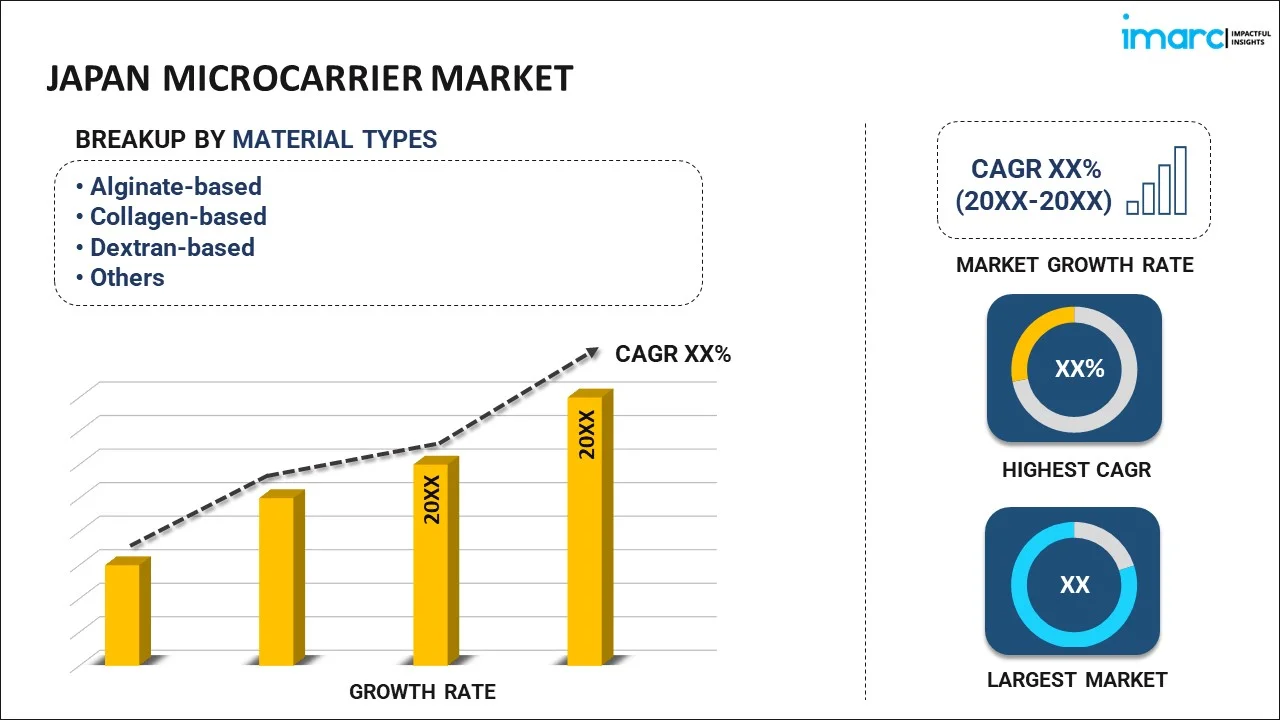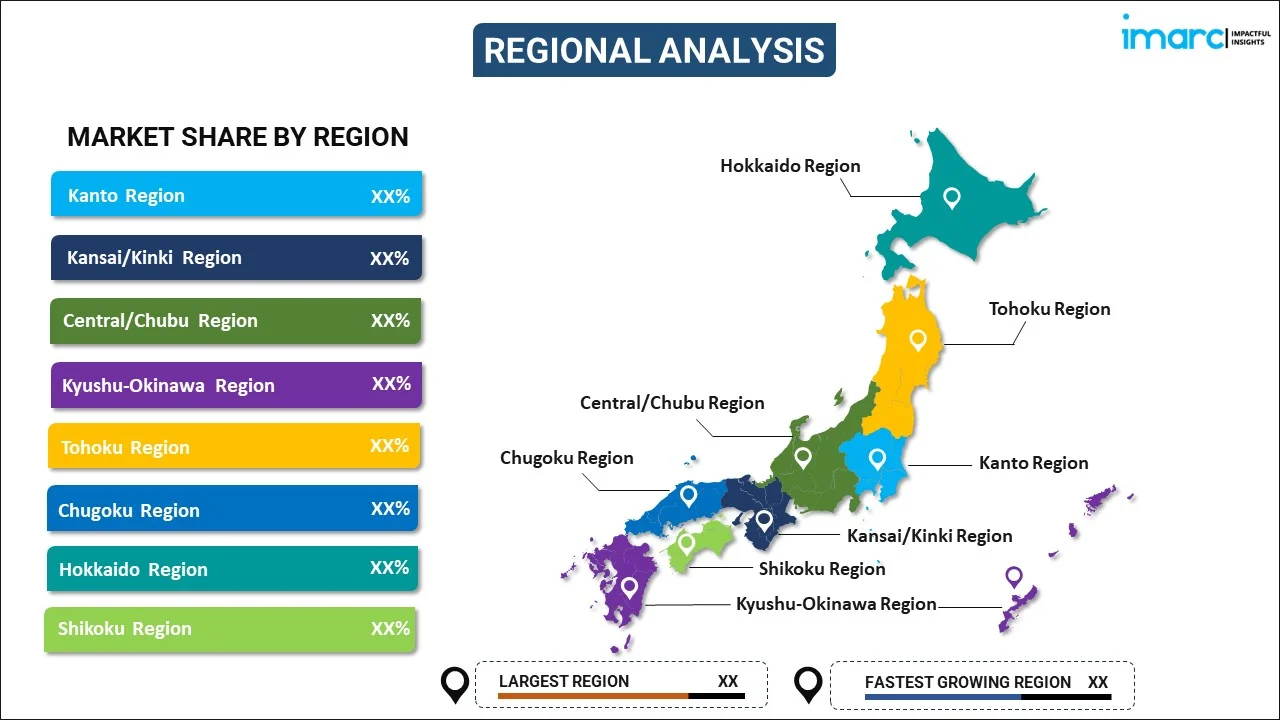
Japan Microcarrier Market Report by Material Type (Alginate-based, Collagen-based, Dextran-based, Polystyrene-based, and Others), Application (Vaccine Manufacturing, Cell Therapy, and Others), End User (Pharmaceutical and Biotechnology Companies, Academic and Research Institutes, Contract Research Organizations (CROs), and Others), and Region 2025-2033
Market Overview:
Japan microcarrier market size reached USD 102.9 Million in 2024. Looking forward, IMARC Group expects the market to reach USD 257.2 Million by 2033, exhibiting a growth rate (CAGR) of 10.7% during 2025-2033. The increasing prevalence of chronic diseases and the emergence of novel pathogens, coupled with the growing need for vaccines and cell-based therapies, is driving the market.
|
Report Attribute
|
Key Statistics
|
|---|---|
|
Base Year
|
2024 |
|
Forecast Years
|
2025-2033
|
|
Historical Years
|
2019-2024
|
| Market Size in 2024 | USD 102.9 Million |
| Market Forecast in 2033 | USD 257.2 Million |
| Market Growth Rate (2025-2033) | 10.7% |
A microcarrier is a tiny, bead-like substrate used in various biotechnology and cell culture applications. Typically made from materials like polystyrene or dextran, these microcarriers provide a solid surface for cells to attach and grow, mimicking their natural environment. Microcarriers are especially useful in the production of vaccines, therapeutic proteins, and other biopharmaceuticals. In bioprocessing, microcarriers are suspended in a bioreactor containing nutrient-rich media, and cells adhere to their surfaces, forming a monolayer or clusters. This configuration facilitates the efficient growth and expansion of cells, making it easier to produce large quantities of desired biological products. Microcarriers are employed in various cell culture systems, including adherent cell lines and stem cells. Microcarriers offer several advantages, such as scalability, ease of handling, and increased surface area for cell attachment. They are vital tools in the biotechnology and pharmaceutical industries, enabling the cost-effective and high-yield production of biologics and vaccines, ultimately benefiting medical research and healthcare.
Japan Microcarrier Market Trends:
The microcarrier market in Japan is experiencing robust growth due to several key drivers that are interconnected. Firstly, the increasing demand for cell-based therapies has been a significant catalyst for the market's expansion. As cell culture techniques play a pivotal role in the production of cell therapies, the demand for microcarriers, which provide a three-dimensional environment for cell growth, has surged. Moreover, the biopharmaceutical industry's continual growth has further fueled the microcarrier market. The industry's need for large-scale production of biologics, such as monoclonal antibodies and vaccines, has driven the adoption of microcarriers in bioreactors, as they offer higher cell densities and improved product yields. Furthermore, the ongoing advancements in tissue engineering and regenerative medicine have propelled the demand for microcarriers. These tiny beads enable the efficient expansion and differentiation of stem cells, facilitating breakthroughs in the field of regenerative medicine. Additionally, the increasing focus on personalized medicine and the development of innovative cell-based therapies is expected to drive the microcarrier market in Japan during the forecast period.
Japan Microcarrier Market Segmentation:
IMARC Group provides an analysis of the key trends in each segment of the market, along with forecasts at the country level for 2025-2033. Our report has categorized the market based on material type, application, and end user.
Material Type Insights:

- Alginate-based
- Collagen-based
- Dextran-based
- Polystyrene-based
- Others
The report has provided a detailed breakup and analysis of the market based on the material type. This includes alginate-based, collagen-based, dextran-based, polystyrene-based, and others.
Application Insights:
- Vaccine Manufacturing
- Cell Therapy
- Others
A detailed breakup and analysis of the market based on the application have also been provided in the report. This includes vaccine manufacturing, cell therapy, and others.
End User Insights:
- Pharmaceutical and Biotechnology Companies
- Academic and Research Institutes
- Contract Research Organizations (CROs)
- Others
The report has provided a detailed breakup and analysis of the market based on the end user. This includes pharmaceutical and biotechnology companies, academic and research institutes, contract research organizations (CROs), and others.
Regional Insights:

- Kanto Region
- Kansai/Kinki Region
- Central/ Chubu Region
- Kyushu-Okinawa Region
- Tohoku Region
- Chugoku Region
- Hokkaido Region
- Shikoku Region
The report has also provided a comprehensive analysis of all the major regional markets, which include Kanto Region, Kansai/Kinki Region, Central/ Chubu Region, Kyushu-Okinawa Region, Tohoku Region, Chugoku Region, Hokkaido Region, and Shikoku Region.
Competitive Landscape:
The market research report has also provided a comprehensive analysis of the competitive landscape. Competitive analysis such as market structure, key player positioning, top winning strategies, competitive dashboard, and company evaluation quadrant has been covered in the report. Also, detailed profiles of all major companies have been provided.
Japan Microcarrier Market Report Coverage:
| Report Features | Details |
|---|---|
| Base Year of the Analysis | 2024 |
| Historical Period | 2019-2024 |
| Forecast Period | 2025-2033 |
| Units | Million USD |
| Scope of the Report | Exploration of Historical and Forecast Trends, Industry Catalysts and Challenges, Segment-Wise Historical and Predictive Market Assessment:
|
| Material Types Covered | Alginate-based, Collagen-based, Dextran-based, Polystyrene-based, Others |
| Applications Covered | Vaccine Manufacturing, Cell Therapy, Others |
| End Users Covered | Pharmaceutical and Biotechnology Companies, Academic and Research Institutes, Contract Research Organizations (CROs), Others |
| Regions Covered | Kanto Region, Kansai/Kinki Region, Central/ Chubu Region, Kyushu-Okinawa Region, Tohoku Region, Chugoku Region, Hokkaido Region, Shikoku Region |
| Customization Scope | 10% Free Customization |
| Post-Sale Analyst Support | 10-12 Weeks |
| Delivery Format | PDF and Excel through Email (We can also provide the editable version of the report in PPT/Word format on special request) |
Key Questions Answered in This Report:
- How has the Japan microcarrier market performed so far and how will it perform in the coming years?
- What has been the impact of COVID-19 on the Japan microcarrier market?
- What is the breakup of the Japan microcarrier market on the basis of material type?
- What is the breakup of the Japan microcarrier market on the basis of application?
- What is the breakup of the Japan microcarrier market on the basis of end user?
- What are the various stages in the value chain of the Japan microcarrier market?
- What are the key driving factors and challenges in the Japan microcarrier?
- What is the structure of the Japan microcarrier market and who are the key players?
- What is the degree of competition in the Japan microcarrier market?
Key Benefits for Stakeholders:
- IMARC’s industry report offers a comprehensive quantitative analysis of various market segments, historical and current market trends, market forecasts, and dynamics of the Japan microcarrier market from 2019-2033.
- The research report provides the latest information on the market drivers, challenges, and opportunities in the Japan microcarrier market.
- Porter's five forces analysis assist stakeholders in assessing the impact of new entrants, competitive rivalry, supplier power, buyer power, and the threat of substitution. It helps stakeholders to analyze the level of competition within the Japan microcarrier industry and its attractiveness.
- Competitive landscape allows stakeholders to understand their competitive environment and provides an insight into the current positions of key players in the market.
Need more help?
- Speak to our experienced analysts for insights on the current market scenarios.
- Include additional segments and countries to customize the report as per your requirement.
- Gain an unparalleled competitive advantage in your domain by understanding how to utilize the report and positively impacting your operations and revenue.
- For further assistance, please connect with our analysts.
 Inquire Before Buying
Inquire Before Buying
 Speak to an Analyst
Speak to an Analyst
 Request Brochure
Request Brochure
 Request Customization
Request Customization




.webp)




.webp)












